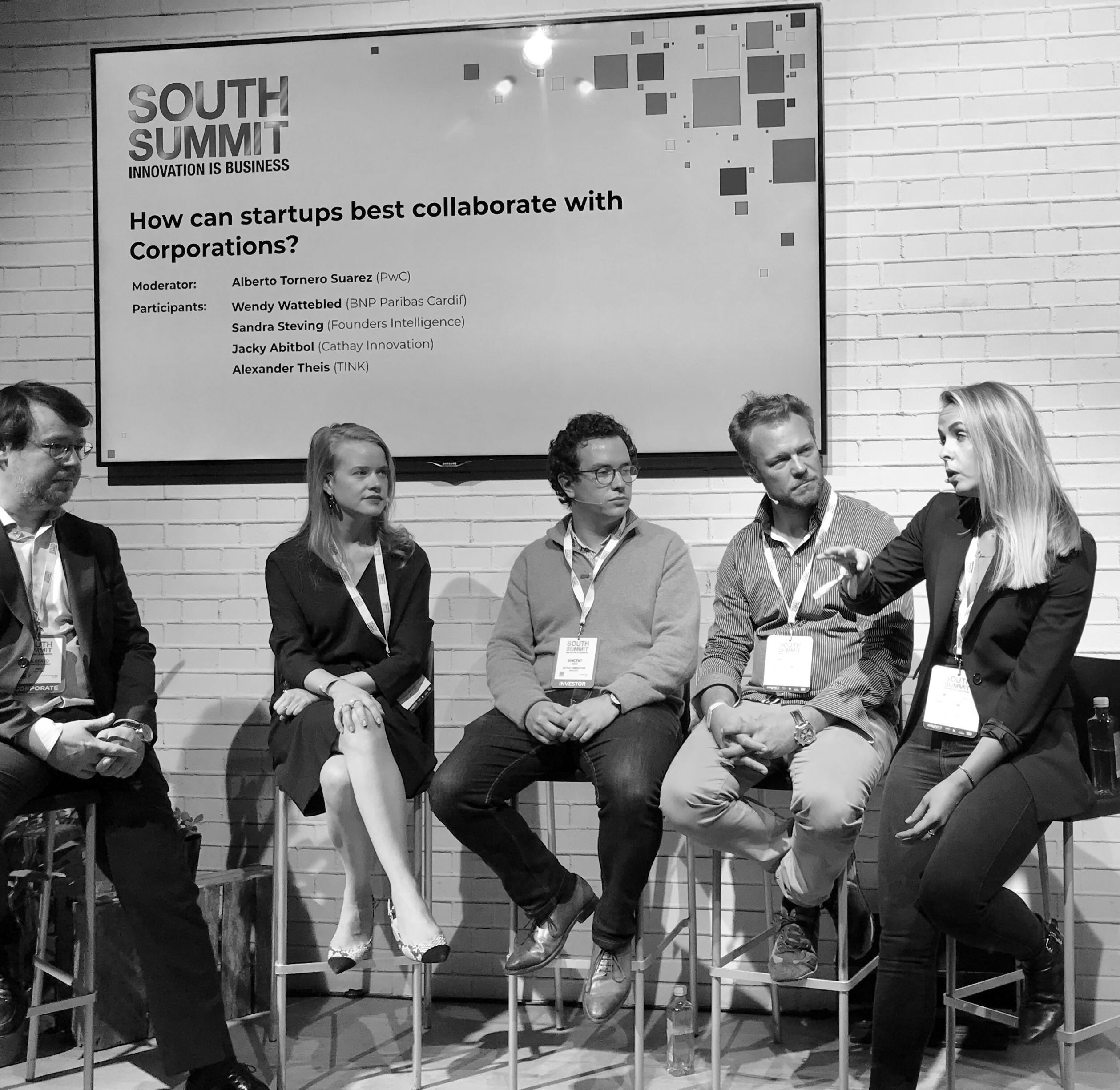South Summit 2019 Panel Highlights: How Start-Ups Can Best Collaborate with Corporates
By Sandra Steving Villegas, Isabel Martinez-Monche, Ana Sofia Almagro
We are bullish about Spanish corporates’ positioning to become technology-first businesses. Our work in Spain has involved sectors from luxury goods, media, and financial services, and we find Spanish corporates are ready to dive into experimenting with new business models, new technologies, and new partners — which is why we were at South Summit. Our Head of Innovation at Founders Intelligence was part of a panel precisely on collaboration between start-ups and corporations. We extracted highlights and insights in bite-sized pieces for your reading pleasure.
“It is about figuring out how to make the elephants dance with the gazelles without crushing them”

Moderator: PWC, Alberto Tornero Suarez
The challenger consultancy: Founders Intelligence, Sandra Steving Villegas
The fund: Cathay Innovation, Vincent Sebag
The start-up: TINK, Alexander Theis
The corporate: BNP Paribas Cardif, Wendy Wattebled
How best to foster the corporate <> start-up dance has been subject of many reports, debates, and budgets for the past couple of decades; all the panelists agreed enabling these collaborations makes sense, but all had some caveats and recommendations. Founders Intelligence’s Sandra summarised it this way:
“[Collaboration] can and will work… but it is important to understand what each of the sides is trying to achieve… I have seen a professionalisation of the space… any corporate who has some salt has an open innovation function or some other way to engage with innovation… this has created a lot of momentum but also frenzy, noise, and counting volume of introductions as metrics- but not impact”
Let’s dive into these two perspectives, from start-ups and corporates alike, to understand some of the challenges and perspectives on both sides of this dance.
The Corporate Perspective
Start-up collaboration is the new R&D, but only if it is done with clear intent, strategy, and internal buy-in.
1. There is a difference between collaborating for the sake of collaborating, and collaborating for impact — identify your ‘why’.
Sandra described four general types of collaboration with start-ups, with the differences depending largely on the corporate’s appetite and commitment:
- “Investment: Corporate investing in a start-up to achieve strategic alignment or keep an eye on the latest innovations
- Off the Shelf: Adoption of an off-the-shelf solution ready to deploy, which is the most common one she sees
- New Technology: Experimenting with a new technology brought in by the start-up, but this is very hard and succeeds under very specific circumstances
- True Joint Venture: Joining of the assets and visions together to create something truly novel — this is both rare, but also where corporates should be focusing more of their attention”
2. Start-up collaboration is slowly replacing R&D — you will need to professionalise your approach to collaboration.
Wendy, from BNP Paribas in Cardiff, said that the important thing was really understanding the underlying issues:
- “[Collaboration issues] are not a matter of age or culture but it is knowing who is behind the desk and what their typical issues are: IT, security, procurement etc. Many start-ups don’t understand these are going to be issues and they can get in the way of fruitful collaboration”
3. The balance of power is shifting — make sure you are the start-ups’ partner of choice.
Wendy also made clear that it is not simply a buyer’s market for innovation anymore:
- “We see the balance of power shifting: start-ups are starting to have more power than the start-ups and corporates had realised; and that to get access to the best start-ups they need to professionalise…it is important to make the transformation internally and become a preferred partner to have the access to the best start-ups”
The Start-Up Perspective
There is a lot to learn from corporates, but the advice was to proceed with caution, as corporates have constraints start-ups have to be ready to navigate.
1. Work with corporates to understand more about your product, and position yourself strategically with the right partner.
Vincent, from Cathay Innovation, put it well:
- “Corporates are experts, they know the space. They will tell us if the product works, they usually have something valuable to say, and are very knowledgeable. Companies can also often acquire the start-ups so, if there is a fit, so it can make sense to align early on”
2. Identify the corporate partner and, importantly, the right stakeholder within the corporate- and add value to them.
Alexander, from TINK, made this point succinctly:
- “The key is to find the internal person who will benefit from your product — you’re working with people, not a company name. Find your internal champion”
While Sandra Villegas advised start-ups to:
- “Ask the corporate how many scale-ups they have, not how many partnerships they have; that is how you will know if they have the right infrastructure in place to make the collaboration grow”
3. Prepare for the internal corporate barriers, be persistent.
Alexander from TINK re-emphasised the need for internal champions:
- “Working with a giant- a bank- you expect a large company to follow your rhythm, but that’s impossible; you need to be persistent and to understand who will be your counterpart within the corporate”
Stay tuned for highlights from our upcoming events where we interview start-ups and corporates for insights on how to get from pilot to scale, the key to impactful collaboration!


